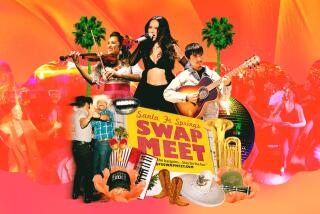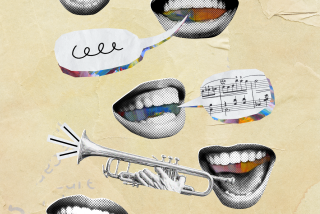EL SERENO : Young Dancers and Ancient Footsteps
Before he begins an Aztec dance, Raul del Toro holds up a clay figure of the god Huehueteotl, points it east, west, north and south, and prays for permission to dance the steps created by the pre-Columbian people.
To him and other members of the Wilson High School dance troupe the moment is taken seriously because it connects the past with the present. Huehueteotl is considered the grandfather of the Aztec gods.
“I do take it seriously, but some people are there just to perform,” said del Toro, 18. “When I do that, it’s with a certain respect. I think it’s very beautiful.”
Interest in the Aztec-era dances has heightened since last year’s quincentennial Columbus Day events, said Wilson High teacher Andres de la Garza. He has been teaching students the simple but physically demanding Aztec dance steps for almost four years.
De la Garza said two men of Aztec descent from Mexico City visited him at the school and tried to sell some costumes they had assembled. The intricate feathered outfits and masks so intrigued the teacher that he bought them and developed a relationship with the two men.
“All that feather work is really quite artistic,” said De la Garza. “I took an interest in what they were doing and so they started teaching me.”
They showed him some traditional Aztec steps and the meaning behind them, which had been passed on to them by their ancestors. In turn, De la Garza passed the knowledge on to his class of 35 students. About 15 students perform Mexican folkloric dances.
“According to the Aztec religion, the fire dance was done at the end of one of their centuries. They would extinguish all the fires in their city and relight it to make sure that their civilization remained,” said De la Garza, 41, after practice last week. “The dances were totally interwound with their religion.”
Unlike the Spanish-influenced folkloric dances that are performed in regional costumes and to the tunes of regional music, the Aztec dances are accompanied by drumming that takes on a different rhythm for each dance. The men from Mexico City, cousins Juan and German Salinas, carved a drum for the Wilson High students. The drum is made from a tree trunk, with the face of Mother Earth surrounded by sculpted feathers as the centerpiece.
The costumes are made of gold metallic material sewn on black, bright green and blue material to form the faces of owls, eagles, serpents or warriors. Gold beads hang from each piece. The headdresses are made of brown and white cock feathers and fabric that match the pectoral and loin pieces.
One outfit can cost $1,500, and the group has conducted chocolate and bake sales to raise money for the costumes. The school has pitched in for some of the cost, as has De la Garza.
The troupe practices four days a week throughout the school year and performs about twice a month.
For De la Garza, who grew up in East Los Angeles, the interest in the indigenous peoples who populated the area that is now Mexico City is encouraging. “When I was growing up, we weren’t allowed to speak Spanish except at home,” he said. “I think the Columbus (anniversary) has added a lot of focus to the roots that were lost.”
More to Read
Sign up for Essential California
The most important California stories and recommendations in your inbox every morning.
You may occasionally receive promotional content from the Los Angeles Times.









